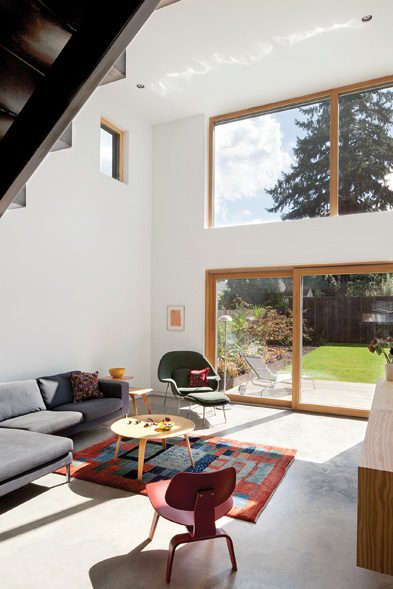European Windows Boost U.S. Performance and Design
It’s All in the Install
Even the world's best windows can't overcome a poorly crafted installation designed by an inexperienced architect or mounted by an inexpert contractor, however. “The junction of window and wall is quickly becoming one of the most important, if not the most important, remaining weak spot” for high-performance architecture, says Zola's Speier. The window-wall interface, detailed with continuous insulation (ci) and properly flashed and sealed air barriers, is essential to meeting energy-efficiency goals.

Photo courtesy of Zola European Windows
This modern home interior, with European windows, shows how even very large openings are used, reflecting improved comfort for occupants while increasing available daylight and controlling solar heat gain to desired levels.
This means the end to some commonly used construction practices that limit effectiveness, such as nailing flanges, outside flush installs and pans to set the window on, says Speier. A new set of tools and techniques is required, and architects need to understand the implications of moisture management as much as the other commonly reviewed window specs.
Better installations are more than a matter of opinion. Installation performance—given as a variable Ψinstall or “Psi install” in building science literature such as Passive House standards and European energy-efficiency handbooks1—is the measure of the linear thermal bridge at the junction of the wall and the window frame. The measure Ψinstall accounts for all additional losses or unexpected gains that make the installed window performance differ from the simple calculation window thermal efficiency—for example, X square feet of R-50 wall and Y square feet of an R-8 window equals the total assembly performance of, let's say, R-37. This assumes a zero Psi install (Ψinstall); but if it's a positive Psi install, that means there are additional thermal losses to consider.
Design considerations include the window's position in the envelope. For example, if the window is flush to the building exterior, it will generally have worse performance (Psi install) than if the window is centered within the wall section. But any installation position will introduce new heat flows and, therefore, inefficiencies; for this reason, some architects detail the opening with additional foam insulation mounted on the outside and inside of the window—in effect, overlapping the wall and the window, which yields better performance than the simple sum of window and wall.
In general, the wall section should be reviewed to ensure there are no thermal bridges; if the design team sees steel or concrete penetrating through the envelope, performance losses will be significant. The window should be centered and “over-insulated” to earn significant increases in the structure's thermal performance of the building.
How do Ψinstall considerations affect the architect's design and contractor's work? There are basically three phases that characterize the high-performance install from the merely adequate or subpar:
Rough opening preparation. As compared to an outside, flush installation, locating the window at some midpoint in the envelope means the rough opening must be carefully detailed. Exposure to water is expected, and flashing tapes should be combined with careful returns of the flashing and façade materials. Highly effective are vapor permeable, fluid-applied flashing materials, which are less prone to problems in the corners of the rough opening. (They also eliminate the potential errors in applying flashing tapes, such as poor lapping.) Good flashing ensures continuity of the airtight layer in the enclosure. “A conventional window install involves dozens of potential failure points for reverse lapping or air leaks. We've eliminated all of that in favor of a seamless, more foolproof system,” says Sam Hagerman, co-owner of Hammer & Hand and president of the Passive House Alliance U.S.
Window install. There are four steps in the window installation itself: structural attachment to the wall assembly with screws or clips, waterproofing to the rough opening, insulating between the window frame and the rough opening edges, and making the interface airtight. Tapes and sealants provide for the waterproofing, gap insulation, and airtight connection. But “filling the gap” must be done with care; this is like a miniature wall assembly that must be able to dry either to the inside or outside, depending on the climate zone. So tapes made for outside waterproofing and inside airtight connections are different, engineered to create a proper mini-wall, not a “vapor-barrier sandwich.” Filling with low-expansion foam increases thermal performance better than a hollow gap.
Over-insulation. This refers not to excessive insulation but rather adding a layer of insulating material at the window jamb and over a portion of the window frame assembly. Depending on the window design, hardware location, frame cladding, and swing direction, overinsulation can be a valuable way to improve thermal performance. In some cases, up to 3 inches of exterior insulation can be added to the exterior of European tilt-and-turn windows, covering most of the frame area. Other windows with recessed aluminum cladding can be detailed with overinsulation connected directly to the wood subframe. The overinsulation can be applied to the interior side of some windows if room allows for proper and comfortable hardware operation, but some window assemblies—such as outswinging models—may not allow for exterior overinsulating.
In these ways, installation details affect the building's overall energy performance and environmental impact. Seemingly minor adjustments at the window-wall interface actually have a significant impact on carbon footprint.









